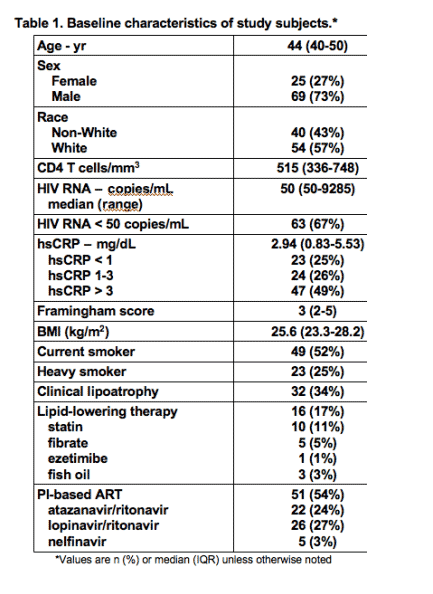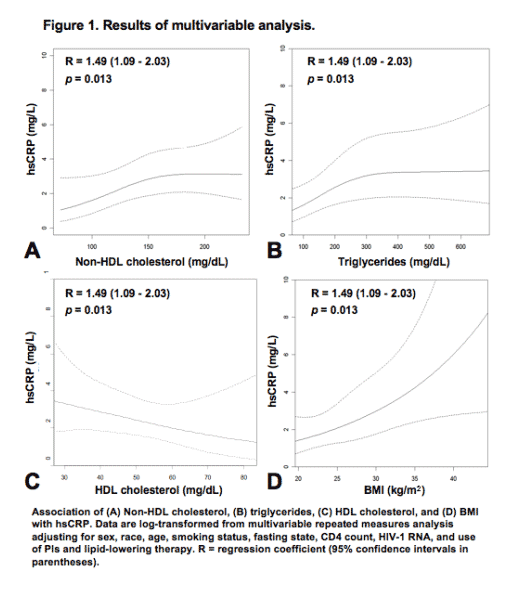 |
 |
 |
| |
Highly-sensitive C-reactive protein (hsCRP) is associated with body mass index (BMI) and serum lipids in HIV-infected patients with low cardiovascular disease (CVD) risk and virologic suppression on antiretroviral therapy (ART)
|
| |
| |
Reported by Jules Levin
IAC Mexico City Aug 2008
M. Boger MD,1 A. Shintani,2 V. Mitchell,1 H. Erdem,1 L.A. Dageforde,1 D. Haas,1 T. Hulgan1
Department of Medicine,1Division of Infectious Diseases and 2Department of Biostatistics, Vanderbilt University School of Medicine, Nashville, Tennessee, USA
AUTHOR CONCLUSIONS
In these HIV-infected subjects with well-suppressed HIV-1 RNA on ART and low CVD risk by traditional Framingham criteria, hsCRP was elevated and independently associated with BMI and serum lipid changes.
Larger studies utilizing additional CVD measures are warranted to confirm and extend these findings.
AUTHOR DISCUSSION
High hsCRP at enrollment suggests high CVD risk, despite a median Framingham risk score indicating low risk
These data highlight disparities in long-term CVD risk in HIV-infected patients on ART and traditional CVD risk factors
BMI may be useful for predicting CVD risk despite anthropomorphic changes related to ART exposure
This is one of few studies to date to model longitudinal changes in lipids and hsCRP in HIV-infected individuals
Study limitations:
--Not all subjects were fasting at study visits
--Non-HDL cholesterol was used
Some subjects missing LDLc data
--Lipoatrophy assessments were subjective
--Other markers of CVD risk were not studied
ABSTRACT
Background: Metabolic abnormalities complicating ART may lead to increased CVD risk. hsCRP predicts CVD risk in the general population; less is known about its use in HIV-infection. Our objective was to assess relationships between hsCRP and metabolic parameters in HIV-infected patients on ART.
Methods: Data are from a prospective cohort of HIV-infected adults enrolled June 2005-July 2007. Eligible subjects were on ART with ≥ 2 nucleoside reverse transcriptase inhibitors (NRTIs), had HIV-1 RNA <10,000 copies/mL plasma, and no known diabetes or CVD. Clinical data were collected at each visit. Non-linear mixed-effect regression models were used to assess effects of BMI and lipid changes on hsCRP over time, adjusting for gender, age, race, smoking status, fasting state, protease inhibitor (PI) use, lipid-lowering therapy, CD4 count and HIV-1 RNA.
Results: 94 subjects had data available from at least one visit, 65 from two visits, 41 from three visits, and 19 from four visits. Median age was 44 years, 27% were female, 43% of non-white race, 34% had clinical lipoatrophy, 17% on lipid-lowering therapy, and 54% on a PI. Median CD4, HIV-1 RNA, and hsCRP were 515 cells/mm3, <50 copies/mL, and 2.94 mg/dL, respectively. In multivariable repeated measures analysis adjusting for covariates, there were significant correlations between increased hsCRP and greater BMI (p=0.005), higher non-HDL (p=0.013) and triglycerides (p=0.017), and lower HDL (p=0.015).
Conclusions: In this group of HIV patients with low CVD risk and virologic suppression on ART, hsCRP was independently associated with BMI and serum lipid changes. These results suggest that hsCRP may be of value for assessing certain HIV-infected patients for metabolic complications and CVD risk on ART. Future studies should assess associations between hsCRP and clinical outcomes.
INTRODUCTION
ART dramatically improves HIV morbidity and mortality. Metabolic ART complications are similar to features of metabolic syndrome- abdominal obesity/lipodystrophy, insulin resistance, and dyslipidemia.
Combination ART including PIs may be associated with increased CVD risk. ART interruption has been associated with fatal or nonfatal CVD risk. Thus, ART, uncontrolled HIV replication, or both, may contribute to greater long-term CVD risk in HIV-infection.
We suspect that CVD risk factors underestimate CVD risk in HIV-infected patients on ART. Other surrogate markers of CVD risk are needed in this patient population. hsCRP correlates with CVD risk and outcome in the general population. hsCRP levels <1, 1-3, and >3 mg/dL correspond to low-, average-, and high-CVD risk, respectively. Little knowledge exists regarding the role of hsCRP in HIV-infected patients.
Subjects with AIDS or uncontrolled plasma viremia have been shown to have higher hsCRP than those with virologic control. Uncontrolled viral replication may limit interpretation of hsCRP in this population.
Study Objective: To assess associations between hsCRP and other markers of metabolic disease and CVD risk in HIV-infected patients with virologic suppression on ART.
METHODS
Study Design: Data are from the Lipoatrophy and Neuropathy Cohort (LiNC) Study, a prospective cohort of chronic HIV-infected adults on ART enrolled June 2005 - July 2007.
Inclusion criteria:
Current ART including ≥ 2 NRTIs at least 24 consecutive weeks ≥ 18 years of age
Plasma HIV-1 RNA <10,000 copies/mL within 180 days of enrollment HIV infection ≥ 12 mos
Two study groups:
--Clinical evidence of peripheral neuropathy and/or lipoatrophy
--Neither symptoms nor clinical evidence of peripheral neuropathy or lipoatrophy
Exclusion criteria:
--Active opportunistic infection within 30 days of enrollment and/or induction phase of therapy
--Documented lactic acidosis within 12 mos
--Diabetes mellitus not diet-controlled
--History of myocardial infarction
--Expected survival < 2 years
--Active neoplasm or systemic chemotherapy within 12 mos
Data Collection: At each visit, BMI, smoking status, and use of anti-inflammatory medications were assessed. Serum was obtained at each visit for lipids and hsCRP. Not all subjects were fasting at study visits. Corresponding CD4 count and HIV-1 RNA were obtained from the medical record. Data on fasting state were collected and included in multivariable models. Lipoatrophy was determined based on grading of subcutaneous fat loss in the face, extremities, or buttocks.
Data analysis: Spearman's correlation was used for unadjusted effects of factors on hsCRP at baseline. Adjusted effects of BMI and lipids on hsCRP were evaluated with data at all four time points by non-linear multivariable general linear models with bootstrapping, adjusting for sex, race, age, smoking status, fasting state, CD4, HIV-1 RNA, and PI and lipid-lowering medication use. Bootstrap variance-covariance estimation was used in the general linear models to account for dependence in within patient repeated measures.
RESULTS
94 individuals were included for analysis. Baseline characteristics are shown in Table 1
65 persons had 2 follow-up visits, 41 had 3 follow-up visits, 19 had 4 follow-up visits
Median (IQR) follow-up was 124 (90-197) days between study visits; overall follow-up time was 230 (113-362) days
Median Framingham risk score of 3 in males and females reflects a 10-year CVD risk of 5% and 3%, respectively
By univariate analysis hsCRP was directly associated with BMI (r=0.263, p=0.012), but not with other covariates,
By multivariable analysis temporal changes in hsCRP were associated with changes in BMI, non-HDL and HDL cholesterol, and triglycerides (Figure1)


|
| |
|
 |
 |
|
|